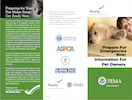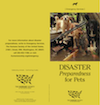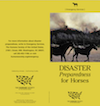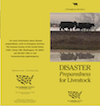Preparing Your Pets for a Disaster
Here are the essentials to have in your Disaster Kit for your pets. This list is based on the FEMA brochure, Preparing Your Pets for Emergencies.
- Water: Make sure you have water for your pet!
- Food: At least 3 days of food for each pet in a sealed bag. My 15 Minute Grab List includes grabbing an entire bag of dog food.
- Portable Bowls: I like these collapsible bowls because they are durable and easy to pack. They are safe for humans to use, so they can be used in a variety of ways.
- Medicines and Medical Records: It’s good to keep some meds inside the Bug Out Bin (BOB), but I always worry about them expiring. So my 15 Minute Grab list includes a note to grab our dog’s meds.
- Collar with ID, Harness or Leash: I have an old collar and leash in our BOB. I got a tag at a pet store with our dog’s name, my cell, our county and her registration number with our county.
- Crate or Pet Carrier: I purchased a pop up crate which I keep next to our BOB. This works for us because our dog would not try to chew through it. If you need to use a more durable carrier that can’t fit in your BOB, then make sure you list it on your 15 Minute Grab List.
- Sanitation: Add some poop bags, pet litter and a small litter box into the BOB. Again … add these to your “grab list” if they are too bulky for the BOB.
- Proof of Ownership: You may need to prove that you own your pet. Try to pack copies of your adoption or purchase. Include photos of you and your pet together. Have your pet chipped if possible.
- Familiar Items: Your pet will also be stressed. Pack some familiar toys, treats and/or bedding.
Download these brochures
If you missed this in Step 1, be sure to download these brochures on how to prepare your pets for a disaster.
Publications for Pets and Livestock ...
Publications for PETS AND LIVESTOCK
| Image | Publication | Org | Notes |
|---|---|---|---|
 | FEMA Information for Pet Owners | FEMA Ready America | Publication R-7 Brochure on how to prepare for pets. |
 | FEMA Pet Checklist | FEMA Ready America | Emergency Kit for pets. |
 | Red Cross Pets and Disaster Safety Checklist | Red Cross | What to do for your pets before and during a disaster. |
| Web Page | Red Cross First Aid Kit for Pets | Red Cross | A list of items to have on hand to administer first aid to a pet injured in a disaster. |
 | HSUS Disaster Preparedness for Pets | HSUS | Brochure on how to prepare and manage disasters with pets. |
 | HSUS Disaster Preparedness for Horses | HSUS | Brochure on how to prepare and manage disasters with horses. |
 | HSUS Disaster Preparedness for Livestock | HSUS | Brochure on how to prepare and manage disasters with livestock. |
Human vs Pet First Aid Kits
If you have a pet, then you’ll also be thinking about first aid for your animal. I discovered that there is a BIG overlap between the Pet First Aid kit and the Human First Aid Kit, but the Pet kits can be much more expensive. After you see the table below, you may reconsider purchasing one of those Pet kits.
Human vs Pet First Aid Kit Comparison
I compared the First Only All Purpose 299 Piece Kit (for humans) and the American Kennel Club (AKC) Pet First Aid Kit 100 Piece Kit with Tick Removal to see if the Pet First Aid kit was worth the extra money. I discovered that the Human First Aid kit was more comprehensive and provided most of the same items in the Pet First Aid Kit … but at a lower cost. While the Pet First Aid kit included some pet specific items, I realized that I already owned most of those things — I’ve got tick removers, extra collars, leads and LOTS of poop bags! Look at the list to see how many of those items you already own.
NOTE: The cost of these kits is an approximation, since prices change and vary between stores. They are just meant to give you a sense of the cost differences.
| First Only 299 Piece Kit ($15) | AKC Pet First 100 ($38) |
|---|---|
| (75) 3/4" x 3" Adhesive Plastic Bandages | |
| (20) 3/4" x 3" Fabric Bandages | Bandages (vague about what type) |
| (30) 1" x 3" Adhesive Plastic Bandages | |
| (10) 1" x 3" Fabric Bandages | |
| (4) Knuckle Fabric Bandages | |
| (4) Fingertip Fabric Bandages | |
| (2) 2" x 4" Elbow & Knee Plastic Bandages | |
| (50) 3/8" x 1 1/2" Junior Plastic Bandages | |
| (1) 1 1/2" x 1 1/2" Patch Plastic Bandage | |
| (3) Butterfly Wound Closures | |
| (6) 2" x 2" Gauze Dressing Pads | 2 Small gauze pads |
| (4) 3" x 3" Gauze Dressing Pads | Cutting Gauze |
| (2) 4" x 4" Gauze Dressing Pads | 2 Large gauze pads |
| (1) 5" x 9" Trauma Pad | 2 Triple-layer medium non stick pads |
| (1) 2" Conforming Gauze Roll Bandage | Roll of gauze for wounds |
| (3) Aspirin Tablet Packs (2) | |
| (3) Ibuprofen Tablet Packs (2) | |
| (3) Extra-Strength Non-Aspirin Tablet Packs (2) | |
| (14) Alcohol Cleansing Pads | 16 Alcohol swabs |
| (15) BZK Antiseptic Towelettes-Sting Free | 6 Medium hand sanitizers |
| (6) Antibiotic Ointment Packs | |
| (2) First Aid/Burn Cream Packs | |
| (3) Insect Sting Relief Pads | 6 sting relief pads |
| (2) 1/2" x 5 yd First Aid Tape Roll | |
| (1) 4" x 5" Instant Cold Compress | 1 instant ice pack |
| (1) Burn Relief Pack-3.5 g | |
| (1) Sterile Eye Pad | |
| (1) Emergency Blanket | Thermal Foil Emergency Blanket |
| (3) 2" x 2" Moleskin Squares | |
| (1) Thermometer-One Time Use | |
| (10) 3" Cotton Tipped Applicators | 16 cotton swabs |
| (2) 6" x 11/16" Finger Splint (or Tongue Depressors) | 5 Tongue Depressors |
| (1) Exam-Quality Vinyl Gloves (Pair) | 6 exam gloves |
| (1) 4 1/2" Scissors-Nickel Plated | 1 metal scissor |
| (1) 4" Tweezers-Plastic | 1 Tweezers |
| (1) First Aid Guide | |
| 6 iodine prep pads for Treatment of wounds and aid in healing. Already included in First Aid Shopping List. | |
| Tick Removal Tool | |
| Magnifying Glass to detect fleas, ticks, stingers. |
|
| 10 Styptic Disposable pencils to halt bleeding associated with minor cuts & nail trimming. Already included in First Aid Shopping List. |
|
| 3 Self adhesive wraps (I just bought a roll of vet wrap) | |
| 1 Round container for pet treats | |
| Waterproof Registration and Identification Card | |
| Guide to Keeping your Pet Safe Happy and Healthy |
|
| Emergency Lead with Reflective Tape | |
| Plastic Bottle for Water | |
| Collapsible Water Bowl | |
| Syringe | |
| Four Pet Waste Bags. | |
| Emergency Identification tag | |
| Temporary ID Collar (Writable). |
Additions recommended by my Vet
I asked my vet what she recommended for an emergency kit and I looked at the list in the Dog Owner’s Home Veterinary Handbook (which was identical to the cat one). Below is a list of all of the items that are NOT included in the Pet First Aid Kit. It’s important to note that MOST of these items are important to both humans and pets! For this reason, they are already included in the Disaster Kit – First Aid Shopping Lists. The items in BOLD are the only ones that are very specific to pets.
Instead of spending money on an expensive Pet First Aid Kit, I decided to buy one Human First Aid Kit (which has bandages that can be shared by humans or pets) and then invest money in the items below.
Be sure to check out the web page on creating a comprehensive Disaster Kit – First Aid Kit. It includes shopping lists with most of these items and recommendations on how to use travel bottles to store things you already own.
- Penlight (we are just using one of our small LED flashlights)
- Thermometer (I purchased a second one for our pet. We are NOT sharing the thermometer!)
- Cotton balls
- Vet wrap (which can be used on humans or pets)
- Ace Bandage (3 inches)
- Grooming clippers (I’m just using scissors and a hand razor)
- Needle Nose pliers (I added one of these to my BOB because they could be very handy)
- KY lubricant or petroleum jelly
- Rubbing Alcohol
- Betadine
- Hydrogen Peroxide
- Topical antibiotic ointment (like Polysporin)
- Sterile saline eye wash
- Compressed activated charcoal tablets (5 grams each)
- Diphenhydramine (e.g. Benadryl)
- Aspirin
- Diagel for diarrhea (in dogs)
First Aid Books for Pets
It’s just as important to have a first aid manual for your pet as it is for yourself. These manuals will help you treat injuries until you can get your pet to a veterinarian.
| Image | Item | Notes |
|---|---|---|
 | First Aid Companion for Dogs & Cats | You can purchase this book used for much less. Good if you own a cat and a dog. As far as I can tell, the author is not a veterinarian. |
 | Dog Owners Home Veterinary Handbook | This is also sold used for much less. I like the fact that this book is written by three veterinarians and one MD. If you look at the book on Amazon, you'll see their list for a medical kit. |
 | Cat Owner's Home Veterinary Handbook | Similar to the book above but for cats. |
 | First Aid for Birds | First aid focused specifically on birds. |
Storing the Pet Items
- Medications like Diagel should be kept with the other first aid items that can expire.
- Gallon-sized Freezer Zip Bag in Bug Out Bin is used to store an extra leash, collar with ID tag, roll of poop bags, collapsible bowls, tick remover, micro-chip documents (our proof of ownership) and her vaccination papers. These are most of the pet related items listed at the bottom of the Pet First Aid Kit.

